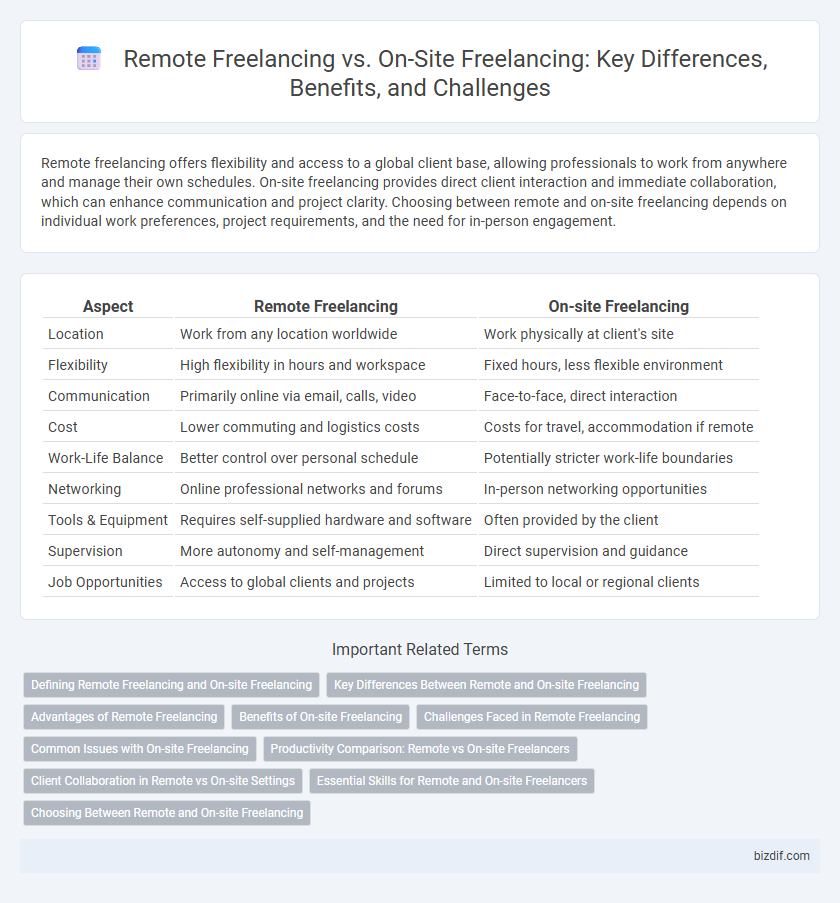Remote freelancing offers flexibility and access to a global client base, allowing professionals to work from anywhere and manage their own schedules. On-site freelancing provides direct client interaction and immediate collaboration, which can enhance communication and project clarity. Choosing between remote and on-site freelancing depends on individual work preferences, project requirements, and the need for in-person engagement.
Table of Comparison
| Aspect | Remote Freelancing | On-site Freelancing |
|---|---|---|
| Location | Work from any location worldwide | Work physically at client's site |
| Flexibility | High flexibility in hours and workspace | Fixed hours, less flexible environment |
| Communication | Primarily online via email, calls, video | Face-to-face, direct interaction |
| Cost | Lower commuting and logistics costs | Costs for travel, accommodation if remote |
| Work-Life Balance | Better control over personal schedule | Potentially stricter work-life boundaries |
| Networking | Online professional networks and forums | In-person networking opportunities |
| Tools & Equipment | Requires self-supplied hardware and software | Often provided by the client |
| Supervision | More autonomy and self-management | Direct supervision and guidance |
| Job Opportunities | Access to global clients and projects | Limited to local or regional clients |
Defining Remote Freelancing and On-site Freelancing
Remote freelancing involves offering professional services from any location using digital communication tools, enabling flexibility and access to global clients without geographic constraints. On-site freelancing requires physically working at the client's location, fostering direct interaction and immediate collaboration but limiting opportunities to local projects. Both models vary in terms of work environment, communication methods, and client engagement strategies.
Key Differences Between Remote and On-site Freelancing
Remote freelancing offers flexibility in location and work hours, allowing professionals to collaborate globally through digital tools, while on-site freelancing requires physical presence at client locations with fixed schedules. Communication in remote freelancing relies heavily on video calls, emails, and project management software, whereas on-site freelancing benefits from face-to-face interactions enhancing immediate feedback and teamwork. Payment structures may vary, with remote freelancers often working on milestone-based contracts and on-site freelancers receiving hourly or daily rates tied to their physical attendance.
Advantages of Remote Freelancing
Remote freelancing offers unparalleled flexibility, allowing professionals to manage their schedules and work from any location worldwide, which enhances work-life balance and productivity. It significantly reduces overhead costs associated with commuting, office space, and daily expenses, increasing net income for freelancers. Access to a global client base expands opportunities, enabling freelancers to diversify their projects and develop specialized skills across various industries.
Benefits of On-site Freelancing
On-site freelancing offers direct access to team members and clients, enhancing communication and collaboration efficiency. It provides immediate feedback and hands-on experience with project requirements, improving the quality of deliverables. This setting fosters stronger professional relationships and networking opportunities within the local industry.
Challenges Faced in Remote Freelancing
Remote freelancing presents challenges such as communication barriers due to time zone differences and reliance on digital tools, which can lead to misunderstandings and project delays. Freelancers often struggle with maintaining work-life balance and staying self-motivated without the structure of a physical office environment. Limited networking opportunities and potential isolation also impact professional growth compared to traditional on-site freelancing.
Common Issues with On-site Freelancing
On-site freelancing often faces challenges such as limited flexibility in work hours and increased commuting time, which can lead to reduced productivity and work-life balance issues. Frequent workplace distractions and rigid office environments may hinder creativity and focus compared to remote settings. Furthermore, on-site freelancers encounter higher operational costs, including transportation and meals, impacting overall earnings.
Productivity Comparison: Remote vs On-site Freelancers
Remote freelancers often experience increased productivity due to flexible work environments and reduced commute times, which can lead to better time management and focus. On-site freelancers benefit from direct supervision and immediate access to team resources, fostering quicker collaboration and problem-solving. Studies show remote workers may complete tasks faster, while on-site workers excel in teamwork-dependent projects, highlighting the importance of aligning work settings with project requirements.
Client Collaboration in Remote vs On-site Settings
Client collaboration in remote freelancing relies heavily on digital communication tools such as video calls, instant messaging, and collaborative platforms, enabling flexible interaction across different time zones. On-site freelancing fosters direct, face-to-face communication, which often enhances immediate feedback, team cohesion, and quicker resolution of project issues. Both settings require clear communication protocols, but remote freelancing demands a stronger emphasis on self-discipline and proactive updates to maintain client engagement.
Essential Skills for Remote and On-site Freelancers
Remote freelancing demands strong communication skills, self-discipline, and proficiency with digital collaboration tools like Slack, Zoom, and project management platforms such as Trello or Asana. On-site freelancing emphasizes interpersonal skills, adaptability to dynamic work environments, and the ability to navigate direct client interactions and immediate feedback. Both require time management, problem-solving abilities, and a clear understanding of client expectations to ensure project success.
Choosing Between Remote and On-site Freelancing
Choosing between remote and on-site freelancing depends on factors such as work-life balance, communication preferences, and project requirements. Remote freelancing offers flexibility, access to a global client base, and reduced commuting time, whereas on-site freelancing facilitates face-to-face collaboration and immediate feedback. Evaluating individual productivity styles and client expectations is critical to making an informed decision that aligns with career goals.
Remote freelancing vs On-site freelancing Infographic

 bizdif.com
bizdif.com